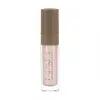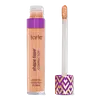What's inside
What's inside
 Key Ingredients
Key Ingredients

 Benefits
Benefits

 Concerns
Concerns

 Ingredients Side-by-side
Ingredients Side-by-side

Water
Skin ConditioningIsododecane
EmollientTalc
AbrasivePEG-10 Dimethicone
Skin ConditioningTriethylhexanoin
MaskingSynthetic Fluorphlogopite
Ethylhexyl Palmitate
EmollientGlycerin
HumectantPropanediol
SolventDisteardimonium Hectorite
StabilisingSambucus Nigra Fruit Extract
AstringentSodium Chloride
MaskingTocopheryl Acetate
AntioxidantTroxerutin
Skin ConditioningAloe Barbadensis Leaf Juice Powder
Skin ConditioningSodium Ascorbyl Phosphate
AntioxidantHexyl Laurate
EmollientPolyglyceryl-4 Isostearate
EmulsifyingCetyl PEG/PPG-10/1 Dimethicone
EmulsifyingXanthan Gum
EmulsifyingCellulose
AbsorbentEthylhexylglycerin
Skin ConditioningPropylene Carbonate
SolventGlyceryl Rosinate
PerfumingPhenoxyethanol
PreservativeAlumina
AbrasiveTriethoxycaprylylsilane
Sodium Sulfate
Silica Dimethyl Silylate
EmollientParfum
MaskingLinalool
PerfumingCitronellol
PerfumingLimonene
PerfumingCI 77891
Cosmetic ColorantCI 42090
Cosmetic ColorantCI 77491
Cosmetic ColorantWater, Isododecane, Talc, PEG-10 Dimethicone, Triethylhexanoin, Synthetic Fluorphlogopite, Ethylhexyl Palmitate, Glycerin, Propanediol, Disteardimonium Hectorite, Sambucus Nigra Fruit Extract, Sodium Chloride, Tocopheryl Acetate, Troxerutin, Aloe Barbadensis Leaf Juice Powder, Sodium Ascorbyl Phosphate, Hexyl Laurate, Polyglyceryl-4 Isostearate, Cetyl PEG/PPG-10/1 Dimethicone, Xanthan Gum, Cellulose, Ethylhexylglycerin, Propylene Carbonate, Glyceryl Rosinate, Phenoxyethanol, Alumina, Triethoxycaprylylsilane, Sodium Sulfate, Silica Dimethyl Silylate, Parfum, Linalool, Citronellol, Limonene, CI 77891, CI 42090, CI 77491
Water
Skin ConditioningDimethicone
EmollientPropanediol
SolventTrimethylsiloxysilicate
EmollientIsododecane
EmollientGlycerin
HumectantCetyl PEG/PPG-10/1 Dimethicone
EmulsifyingPhenyl Trimethicone
Skin ConditioningPEG-10 Dimethicone
Skin ConditioningTriethoxycaprylylsilane
Aluminum Starch Octenylsuccinate
AbsorbentPolyglyceryl-3 Diisostearate
EmulsifyingPolypropylene
Phenoxyethanol
PreservativeDisteardimonium Hectorite
StabilisingHydrogenated Polyisobutene
EmollientMagnesium Sulfate
Sorbitan Sesquiisostearate
EmulsifyingSodium Chloride
MaskingPropylene Carbonate
SolventPolysilicone-11
Ethylhexylglycerin
Skin ConditioningButyrospermum Parkii Butter
Skin ConditioningKaolin
AbrasiveSqualane
EmollientTocopheryl Acetate
AntioxidantMangifera Indica Seed Butter
Skin ConditioningPentaerythrityl Tetra-Di-T-Butyl Hydroxyhydrocinnamate
AntioxidantTocopherol
AntioxidantCentella Asiatica Extract
CleansingGlycyrrhiza Glabra Root Extract
BleachingOpuntia Vulgaris Extract
Skin ConditioningPanax Ginseng Root Extract
EmollientSodium Hyaluronate
HumectantCitric Acid
BufferingSodium Ferrocyanide
Chromium Oxide Greens
Iron Oxides
Water, Dimethicone, Propanediol, Trimethylsiloxysilicate, Isododecane, Glycerin, Cetyl PEG/PPG-10/1 Dimethicone, Phenyl Trimethicone, PEG-10 Dimethicone, Triethoxycaprylylsilane, Aluminum Starch Octenylsuccinate, Polyglyceryl-3 Diisostearate, Polypropylene, Phenoxyethanol, Disteardimonium Hectorite, Hydrogenated Polyisobutene, Magnesium Sulfate, Sorbitan Sesquiisostearate, Sodium Chloride, Propylene Carbonate, Polysilicone-11, Ethylhexylglycerin, Butyrospermum Parkii Butter, Kaolin, Squalane, Tocopheryl Acetate, Mangifera Indica Seed Butter, Pentaerythrityl Tetra-Di-T-Butyl Hydroxyhydrocinnamate, Tocopherol, Centella Asiatica Extract, Glycyrrhiza Glabra Root Extract, Opuntia Vulgaris Extract, Panax Ginseng Root Extract, Sodium Hyaluronate, Citric Acid, Sodium Ferrocyanide, Chromium Oxide Greens, Iron Oxides
Ingredients Explained
These ingredients are found in both products.
Ingredients higher up in an ingredient list are typically present in a larger amount.
This ingredient is a high molecular weight silicone. It has emulsifying and skin conditioning properties.
Disteardimonium Hectorite comes from the clay mineral named hectorite. It is used to add thickness to a product.
It can also help stabilize a product by helping to disperse other ingredients.
Hectorite is a rare, white clay mineral.
Learn more about Disteardimonium HectoriteEthylhexylglycerin (we can't pronounce this either) is commonly used as a preservative and skin softener. It is derived from glyceryl.
You might see Ethylhexylglycerin often paired with other preservatives such as phenoxyethanol. Ethylhexylglycerin has been found to increase the effectiveness of these other preservatives.
Glycerin is already naturally found in your skin. It helps moisturize and protect your skin.
A study from 2016 found glycerin to be more effective as a humectant than AHAs and hyaluronic acid.
As a humectant, it helps the skin stay hydrated by pulling moisture to your skin. The low molecular weight of glycerin allows it to pull moisture into the deeper layers of your skin.
Hydrated skin improves your skin barrier; Your skin barrier helps protect against irritants and bacteria.
Glycerin has also been found to have antimicrobial and antiviral properties. Due to these properties, glycerin is often used in wound and burn treatments.
In cosmetics, glycerin is usually derived from plants such as soybean or palm. However, it can also be sourced from animals, such as tallow or animal fat.
This ingredient is organic, colorless, odorless, and non-toxic.
Glycerin is the name for this ingredient in American English. British English uses Glycerol/Glycerine.
Learn more about GlycerinIsododecane is a fragrance, emollient, and solvent.
As an emollient, it helps your skin stay soft and hydrated. Emollients help trap moisture into your skin.
Isododecane's role as a solvent makes it a great texture enhancer. It spreads smoothly on skin and does not leave a sticky feeling behind. Isododecane also helps prevent color transfer in makeup products.
Isododecane is not absorbed into skin.
Learn more about IsododecanePeg-10 Dimethicone is silicone with conditioner and emulsifier properties. It mostly acts as an emollient in skincare and and humectant in haircare.
According to the manufacturer, acidic formulations decrease the stability of this ingredient. It works best in neutral or near neutral formulations.
Phenoxyethanol is a preservative that has germicide, antimicrobial, and aromatic properties. Studies show that phenoxyethanol can prevent microbial growth. By itself, it has a scent that is similar to that of a rose.
It's often used in formulations along with Caprylyl Glycol to preserve the shelf life of products.
Propanediol is an all-star ingredient. It softens, hydrates, and smooths the skin.
It’s often used to:
Propanediol is not likely to cause sensitivity and considered safe to use. It is derived from corn or petroleum with a clear color and no scent.
Learn more about PropanediolThis ingredient is a solvent. It helps dissolve active ingredients and alter the texture of products.
Propylene Carbonate is commonly used in makeup and with clay, such as montmorillonite or bentonite.
Studies show this ingredient to be safe for cosmetics. When it is undiluted, it can cause skin irritation. (It is always diluted in skincare and makeup). This ingredient is water-soluble.
Propylene Carbonate is created from propylene glycol and carbonic acid.
Learn more about Propylene CarbonateChances are, you eat sodium chloride every day. Sodium Chloride is also known as table salt.
This ingredient has many purposes in skincare: thickener, emulsifier, and exfoliator.
You'll most likely find this ingredient in cleansers where it is used to create a gel-like texture. As an emulsifier, it also prevents ingredients from separating.
There is much debate on whether this ingredient is comedogenic. The short answer - comedogenic ratings don't tell the whole story. Learn more about comegodenic ratings here.
The concensus about this ingredient causing acne seems to be divided. Research is needed to understand if this ingredient does cause acne.
Scrubs may use salt as the primary exfoliating ingredient.
Learn more about Sodium ChlorideTocopheryl Acetate is AKA Vitamin E. It is an antioxidant and protects your skin from free radicals. Free radicals damage the skin by breaking down collagen.
One study found using Tocopheryl Acetate with Vitamin C decreased the number of sunburned cells.
Tocopheryl Acetate is commonly found in both skincare and dietary supplements.
Learn more about Tocopheryl AcetateTriethoxycaprylylsilane is a silicone used to bind and stabilize ingredients.
As an emulsifier, it helps prevent ingredients from separating. This can help elongate the shelf life of products.
Triethoxycaprylylsilane is often used to coat mineral sunscreens ingredients to help give a better feel. It also helps reduce oxidative stress in sunscreens.
Learn more about TriethoxycaprylylsilaneWater. It's the most common cosmetic ingredient of all. You'll usually see it at the top of ingredient lists, meaning that it makes up the largest part of the product.
So why is it so popular? Water most often acts as a solvent - this means that it helps dissolve other ingredients into the formulation.
You'll also recognize water as that liquid we all need to stay alive. If you see this, drink a glass of water. Stay hydrated!
Learn more about Water